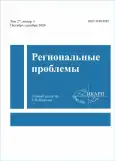Forecast of anthropogenic fire danger for vegetation according to satellite images of the south of the Russian Far East
- Авторлар: Glagolev V.A.1
-
Мекемелер:
- Институт комплексного анализа региональных проблем ДВО РАН
- Шығарылым: Том 27, № 4 (2024)
- Беттер: 72-78
- Бөлім: GEOECOLOGY
- URL: https://journal-vniispk.ru/1605-220X/article/view/284533
- DOI: https://doi.org/10.31433/2618-9593-2024-27-4-72-78
- ID: 284533
Дәйексөз келтіру
Толық мәтін
Аннотация
In this study, a spatial – temporal analysis of separate vegetation fires monitoring data from 2013 to 2023 was carried out on the basis of MODIS satellite images and geographical data from the Open Street Map resource for the subjects in the Russian Far East south. Open thematic maps of the study area are represented by vector layers of settlements and highways. The map spatial objects are subdivided into 12 categories, according to the number of population in the localities (hamlet, village, town) and the type of highways (unclassified, tertiary, secondary, primary, trunk). To create the deterministic probabilistic methodology for predicting the vegetation fires occurrence, the author has proposed an algorithm for determining the anthropogenic load during specified time periods at a fire season in forest and non-forest areas located at a distance up to 12 km near highways and up to 9 km from settlements. The decomposition of multilinear highway objects in the form of a regular network with a resolution of 0.025 degrees in the WSG84 cartographic projection is performed by the author. It is defined the settlements and highway sections in need of forest protection measures – for federal and municipal organizations of the Jewish Autonomous region to perform them. The longest sections of roads characterizes by a high fire danger in April and October are situated in Leninsky and Oktyabrsky districts; the highest fire danger is recorded near the settlement of Yekaterino-Nikolskoye. The methodology verification was made on the example of the fire season in 2023. It was revealed a satisfactory dependence of vegetation fires occurrence in the selected sections with a length of up to 9 km.
Негізгі сөздер
Авторлар туралы
V. Glagolev
Институт комплексного анализа региональных проблем ДВО РАН
Хат алмасуға жауапты Автор.
Email: glagolev-jar@yandex.ru
ORCID iD: 0000-0003-1424-552X
Ресей, ул. Шолом-Алейхема 4, г. Биробиджан, 679016
Әдебиет тізімі
- Andreev Yu.A., Larchenko G.F. Socio-psychological aspects of recreational visits to the forest and the occurrence of fires, in Lesnye pozhary i bor’ba s nimi (Forest fires and their control). Moscow: VNII POM-leskhoz Publ., 1987, pp. 251–263. (In Russ.).
- Glagolev V.A., Kogan R.M. Fire Monitoring System of Forest Plots of Jewish Autonomous Region. Tekhnologii tekhnosfernoi bezopasnosti, 2015, no. 5 (63), pp. 104–112. Available at: http://ipb.mos.ru/ttb/2015-5/2015-5.html (accessed: 14.10.2024). (In Russ.).
- Egarmin P.A. The system of detailed assessment of fire danger of the forest territory. Extended Abstract of Cand. Sci. (technical) Dissertation. Krasnoyarsk, 2005. 21 p . (In Russ.).
- Informatsionnaya sistema distantsionnogo monitoringa Federal’nogo agentstva lesnogo khozyaistva (Information system of remote monitoring of the Federal Forestry Agency). Available at: https://pushkino.aviales.ru/main_pages/index.shtml (accessed: 14.10.2024). (In Russ.).
- Kuznetsov G.V., Baranovsky N.V. Prognoz vozniknoveniya lesnykh pozharov i ikh ekologicheskikh posledstvii (Forecast of forest fires and their environmental consequences). Novosibirsk: SB RAS, 2009. 301 p. (In Russ.).
- Podolskaya A.S., Ershov D.V., Shuliak P.P. Forest Fire Occurrence Probability Assessment: Method and Approach in Russian Remote Monitoring Information System (Isdm-Rosleskhoz). Sovremennye problemy distantsionnogo zondirovaniya Zemli iz kosmosa, 2011, vol. 8, no. 1, pp. 118–126. (In Russ.).
- Rekomendatsii po lesopozharnoi profilaktike i tusheniyu lesnykh pozharov v zone nazemnoi okhrany lesov Dal’nego Vostoka (Recommendations on forest fire prevention and extinguishing of forest fires in the zone of ground protection of forests of the Far East), M.A. Sheshukov, I.Z. Naikrug, I.I. Pereveitailo, E.E. Dunda. Khabarovsk: DalnIILKH, 1983. 44 p. (In Russ.).
- Filkov A.I. Deterministic probabilistic system of forecasting forest fire danger. Extended Abstract of Cand. Sci. (Physical and Mathematical) Dissertation. Tomsk, 2005. 24 p. (In Russ.).
- Geofabric Download Server OpenStreetMap. Available at: https://download.geofabrik.de/russia.html (accessed: 14.10.2024).
- Venter O., Sanderson E.W., Magrach A., Allan J.R., Beher J., Jones K.R., ... & Watson J.E. Global terrestrial Human Footprint maps for 1993 and 2009. Scientific data, 2016, no. 3 (1), pp. 1–10.
- Zubareva A.M., Glagolev V.A., Grigorieva E.A. Characteristics of the spatial and temporal distribution of fire regime in one of the most fire prone region of the Russian Far East Geography. Environment and Sustainability, 2021, vol. 14, no. 2, pp. 74–82.
Қосымша файлдар









